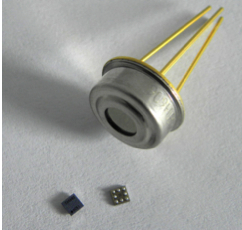TI's contact-less temperature sensor opens up possibilities

Texas Instruments recently brought to market what it claims to be the world's first single-chip passive infrared (IR) micro-electro-mechanical system (MEMS) temperature sensor, called the TMP006.
The TMP006 is a "game changer" that could open up new applications for devices that were previously unable to use IR temperature measurement because of size, power, or costs. That means going past industrial applications to include consumer electronics, such as smartphones, tablets, and notebooks. The invention earned the company an award at CES in Las Vegas last month.
The 1.6 mm x 1.6 mm square dot packs a MEMS thermopile sensor, signal conditioning, 16-bit analogue-to-digital converter (ADC), local temperature sensor, and voltage references all into a package than can be integrated into a silicon manufacturing process. The chip operates from -40 to +125?C, with typical accuracy of ±1?C for the passive IR sensor and ±0.5?C for the local temperature sensor.
Daniel Mar, a product marketing engineer at TI, recently told ZDNet: "We combined the guts that you need in order to take a contact-less temperature measurement and squeeze it into a very low-cost single chip device."
TI says the device is 95% smaller than competitive devices and uses 90% less power for a fraction of the cost. (The TMP006 is priced at $1.50 for 1,000 units). It gives manufacturers the ability to accurately measure device case temperature using IR technology.
"If you put the chip on a motherboard facing the case, it can pick up the energy coming off the case and provide its true temperature," said Mar.
It can also be used to measure temperature outside the device, enabling new features and user applications. For instance, the chip could be added to the assortment of sensors found in smartphones--gyroscopes, cameras and GPS chips--to measure the temperature of objects, food, ambient air, etc.
EN-Genius Acquisition Zone said that the device could find a large range of applications for CPU, motor, power management temperature sensing, and gas detectors. "There are also likely to be applications that simply cannot be thought of at this time."
"One day, you may be able to take your cell phone and put it against your ear and find out if you are running a fever," said Mar.
Sounds like a solid step towards Star Trek 'Tricorder' medical scanners.
